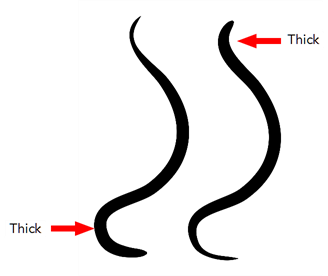Select Tool Options
When you choose the Select ![]() tool, its properties and options appear in the Tool Properties view.
tool, its properties and options appear in the Tool Properties view.

Choose between the Lasso ![]() and Marquee
and Marquee ![]() options to change the selection style of the tool.
options to change the selection style of the tool.
| • | Click and hold Alt to temporarily switch from the current mode to the other. |
You can enable different snapping modes to help you when repositioning drawings using the Select tool.
| • |
| • |
| • |

| 1. | Do one of the following: |
| • | Select View > Grid > Show Grid to display the grid in the Camera or Drawing view or press Ctrl + ' (Windows/Linux) or ⌘ + ' (Mac OS X). |
| • | Select View > Grid > Square Grid, 12 Field Grid or 16 Field Grid for your current needs. |
| 2. | In the Tools toolbar, select the Contour Editor |
| 3. | In the Contour Editor Tool Properties view, click the Snap to Grid |
| 4. | In the Camera or Drawing view, click on the anchor point you want to snap following the grid, drag it to the desired position and release. |


The Select by Colour mode lets you select all the zones in your drawing painted with the same colour.
| 1. | In the Tools toolbar, select the Select |
| 2. | In the Tool Properties view, click the Select by Colour |
| 3. | In the |
All zones of the same colour are selected.
| 4. | Click the Select tool again to return to the regular Select mode. |

The Permanent Selection ![]() option lets you maintain a selection over multiple drawings. Once this option is enabled, the selection zone made using the Select tool will remain as you navigate through drawings from a layer and drawings from other drawing layers. This option can be used to simultaneously delete artwork inside or outside of the selection on several drawings when combined with the Apply to Multiple Drawings option.
option lets you maintain a selection over multiple drawings. Once this option is enabled, the selection zone made using the Select tool will remain as you navigate through drawings from a layer and drawings from other drawing layers. This option can be used to simultaneously delete artwork inside or outside of the selection on several drawings when combined with the Apply to Multiple Drawings option.

The Apply to All Drawings in Layer ![]() option is used to perform an action on all the drawings contained in a layer. For example, you could enable the option to paint a section on all the drawings simultaneously. The Apply Tool to All Drawings option must be activated before performing the action and will stay enabled only for the next action.
option is used to perform an action on all the drawings contained in a layer. For example, you could enable the option to paint a section on all the drawings simultaneously. The Apply Tool to All Drawings option must be activated before performing the action and will stay enabled only for the next action.
The Apply to Line and Colour Art ![]() option uses the concept of Line Art and Colour Art layers. Use this option to apply an action such as selecting or resizing a drawing on both Line Art and Colour Art layers, as well as the Overlay and Underlay layers.
option uses the concept of Line Art and Colour Art layers. Use this option to apply an action such as selecting or resizing a drawing on both Line Art and Colour Art layers, as well as the Overlay and Underlay layers.


By default, when you draw a selection box in the Camera view, the Select tool will select only the drawing strokes of the current drawing. If you prefer the Select tool to select all the strokes on all layers, you can disable the Works on Single Drawing option in the Tool Properties view or the Select Tool Works on Single Drawing preference.

The Flip Horizontal ![]() and Flip Vertical
and Flip Vertical ![]() operations flip the current selection horizontally or vertically.
operations flip the current selection horizontally or vertically.
| ‣ | From the top menu, select Drawing > Transform > Flip Horizontal and Flip Vertical. |

The Rotate 90 Degrees CW ![]() and Rotate 90 Degrees CCW
and Rotate 90 Degrees CCW ![]() operations rotate the current selection 90 degrees clockwise or counter-clockwise.
operations rotate the current selection 90 degrees clockwise or counter-clockwise.
| ‣ | From the top menu, select Drawing > Transform > Rotate 90 Degrees CW and Rotate 90 Degrees CCW. |
| ‣ | Press Ctrl + 7 and Ctrl + 9 (Windows/Linux) or ⌘ + 7 and ⌘ + 9 (Mac OS X). |
The Smooth![]() operation lets you smooth out selected drawing strokes and remove extra points.
operation lets you smooth out selected drawing strokes and remove extra points.
| ‣ | From the top menu, select Drawing |

The Flatten ![]() operation is used to merge drawing objects and brush strokes into a single layer. If you draw new lines to fix a drawing or line with many brush strokes, it can be useful to flatten them all into a single shape. By default, lines are drawn one on top of each other. If you intend to repaint the lines or modify their shape, it will be easier if they are flattened.
operation is used to merge drawing objects and brush strokes into a single layer. If you draw new lines to fix a drawing or line with many brush strokes, it can be useful to flatten them all into a single shape. By default, lines are drawn one on top of each other. If you intend to repaint the lines or modify their shape, it will be easier if they are flattened.
| ‣ | From the top menu, select Drawing |
You can use the outline you traced on one of the four embedded layers and create invisible strokes to paint your drawings on separate layers. This provides more inking and painting flexibility.
You can also configure the option to create the invisible strokes on any of the four embedded layers.
| 1. | In the Tools toolbar, select the Select |
| 2. | In the |
| 3. | In the Drawing View toolbar, click the Create Colour Art from Line Art button or press *. |
| 1. | In the Tools toolbar, select the Select |
| 2. | In the Tool Properties view, Shift + click the Create Colour Art from Line Art |
The Configure Line Art to Colour Art dialog box opens.

| Parameter | Description |
| Use rendered version of the drawing | Renders the drawing and vectorize it to calculate the position of the centreline that will produce the colour art stroke. |
| Maximum Resolution for rendered image | The size of the rendered image. |
| Threshold for rendered image | The value of grey processed to create the rendered vectorized arts. |
| Fitting error for rendered Beziers | This value represents how precise the fitting of the colour art zone in relation to the line art will be. |
| Source layer | Lets you select the layer (Line Art, Colour Art, Underlay or Overlay) you want the colour art to be created from. |
| Destination layer | Lets you select the layer (Line Art, Colour Art, Underlay or Overlay) you want the colour art to be created on. |
| Clear Destination Art Layer First |
Deletes the content before the colour art is added. This is useful when you already have artwork on the destination layer. |
| Perform Line Art to Colour Art Operation Immediately | Performs the Create Colour Art from Line Art command when you click OK. |
The Distribute to Layers ![]() option is used to separate the selected art strokes and send them to new drawing layers. In the Camera view, once you have drawn your artwork, you can select the strokes you want to distribute using the Select
option is used to separate the selected art strokes and send them to new drawing layers. In the Camera view, once you have drawn your artwork, you can select the strokes you want to distribute using the Select ![]() tool and click on the Distribute to Layers
tool and click on the Distribute to Layers ![]() button; you can also select Drawing > Distribute to Layers. It will automatically take every stroke from the drawing selection made in the Camera view and separate them into a different layer for each. If an artwork is composed of several strokes, you must group them using Edit > Group > Group before using the Distribute to Layers option. This option cannot be done from the Drawing view.
button; you can also select Drawing > Distribute to Layers. It will automatically take every stroke from the drawing selection made in the Camera view and separate them into a different layer for each. If an artwork is composed of several strokes, you must group them using Edit > Group > Group before using the Distribute to Layers option. This option cannot be done from the Drawing view.
Use the Store Colour Gradient ![]() operation to record the selected gradient’s position. This reuses the stored position of the gradient when drawing new brush lines or painting colour zones. Enable the Use Stored Colour Gradient
operation to record the selected gradient’s position. This reuses the stored position of the gradient when drawing new brush lines or painting colour zones. Enable the Use Stored Colour Gradient ![]() option in the Paint or Brush Tool Properties view to do this.
option in the Paint or Brush Tool Properties view to do this.

The Pencil to Brush ![]() operation converts the selected centre line pencil strokes into contour strokes brush lines.
operation converts the selected centre line pencil strokes into contour strokes brush lines.
From the top menu, select Drawing > Convert > Pencil Lines to Brush or press &.


Pencil lines are central vector lines and it might be difficult to match pencil line’s tips properly to align them and make it look like it is one single line. With the Select tool, you can select several pencil lines and merge them as one single object using the Merge Pencil Lines ![]() option. The ends of your lines are adjusted to form one single line.
option. The ends of your lines are adjusted to form one single line.
Reverse Pencil Thickness

The Reverse Pencil Thickness ![]() option inverts the thick and thin section on a selected pencil line. This option will take the thickest size on the line and apply it to the thinnest, and it will apply the thinnest to the thickest.
option inverts the thick and thin section on a selected pencil line. This option will take the thickest size on the line and apply it to the thinnest, and it will apply the thinnest to the thickest.
Use the Width and Height operation fields to enter specific values to resize the selected shape with precision.

| 1. | Width: Type a value in this field to resize the width of your selection. |
| 2. | Height: Type a value in this field to resize the height of your selection. |
| 3. | Up/Down arrows: Use the up and down arrows to modify the value in the Width or Height fields. |
| 4. | Lock icon: Click the lock icon to lock or unlock the ratio between the Width and Height values. |
Use the Offset X and Offset Y operation fields to enter specific values and precisely reposition the selected shape.

| 1. | X: Type a value in this field to reposition your selection along the X-axis. |
| 2. | Y: Type a value in this field to reposition your selection along the Y-axis. |
| 3. | Up/Down arrows: Use the up and down arrows to modify the value in the X or Y value field. |
The Angle operation lets you to enter specific values and accurately rotate the selected shape.

| 1. | Angle: Type a degree value in this field to rotate your selection. |
| 2. | Up/Down arrows: Use the up and down arrows to modify the value in the Angle value field. |
Use the Adjusting the Pencil Line Thickness operation field to resize the selected centreline strokes. This operation is not permitted on contour line shapes, such as brush strokes or shape fills.

| 1. | Minimum Size: Type a value in this field to set the minimum thickness of the selected centreline stroke. |
| 2. | Maximum Size: Type a value in this field to set the maximum thickness of the selected centreline stroke. |
| 3. | Up/Down arrows: Use the up and down arrows to modify the value contained in the Thickness value field. |

You can adjust the start, end, and joint style of a selected pencil line.
| • | Start: Lets you select the style of the start tip, which is the first tip you drew. You can choose between Round or Flat style. |
| • | End: Lets you select the style of the end tip, which is the last tip you drew. You can choose between Round or Flat style. |
| • | Join: Lets you select the joint style. The joints are where the line curves abruptly. You could also define the Join style as the corner style. You can choose between Round, Mitre and Bevel style. |

Toon Boom Harmony gives you the flexibility to change the style and thickness of your pencil lines even after they are drawn. You can apply preset pencil stencils or create your own—see Working with Pencil Presets.
Pencil lines support texture. Once a pencil line is drawn, you can apply a preset texture or load your own. Textures are independent from pencil stencils—see Pencil Line Texture.
When you select text with the Select tool, the tool properties will display the Text tool options on the bottom of the view. You can also press Alt + 9 to display only the Text properties in the Tool Properties view—see Text Tool Options.








